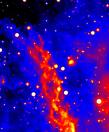This photo was taken a few years ago, judging by the sweater – and I have no memory of who took it, or where.
There’s a story about Magellan’s ships coming across the ocean toward a new shore, and none of the natives on land could see them. The tall European ships simply didn’t exist in the natives’ reality. But the tribe’s shaman, in a state of expanded awareness, sensed the encroaching strangers – and soon everyone else in the village saw them too.
The story of the natives who couldn’t see the ships seems, to me, very much like an old urban legend, most of which are based on a kernel of truth. From my perspective, substituting modern mankind and extraterrestrial airships for the natives and sailing ships gives modern significance to the story of people blinded by their limited scope of reality – an example of “perceptual blindness,” as it’s sometimes called.
I’ve seen many inexplicable aerial objects and apparent non-human vehicles, like the flat black rectangle on the scale of several football fields gently gliding horizontally (and admittedly at a fairly high altitude) over my neighbourhood against a clear blue sky, and the room- or house-sized wingless metallic sphere seen from my doctor’s sixth-floor window, moving with clear intent directly into a gusty February breeze. In fact I’ve seen more UFOs than I can count on both hands and both feet. But why me, and not the guy next door? Perhaps I’ve seen them because on some level I’ve always known that they exist, I fully accept their reality, and subconsciously I expect to see them when they’re around.
Do I, and others who frequently see UFOs, have some kind of enhanced-spectrum vision as opposed to perceptual blindness when it comes to seeing these things? By virtue of our direct experiential knowledge of UFOs, perhaps the craft are (in a manner of speaking) an extension of ourselves – in which case, a nearby UFO grabbing our attention may be as natural as responding when we hear our name spoken in a crowded room.
Your average Joe standing next to me may not perceive a UFO that I see clearly, merely because the arrangement of his ocular cones and rods – tuned by his expectations – doesn’t allow him to see it. And for the implacable skeptic – well, an extraterrestrial vehicle simply isn’t in their realm of possibility, thus I wouldn’t expect them to see a UFO in any case.
Knowledge stimulates a certain response within us. I believe that that to which we are tuned – that which we accept and expect – interacts with us in ways that transcend the mundane. More and more people around the world are beginning to accept the reality of extraterrestrial and/or interdimensional vehicles, and more and more admit believing the craft exist. As seems to be the case with everything else in our reality, the shift is happening faster all the time.
What I’m suggesting is that, when it comes to UFOs, we’re nearing the proverbial 100th Monkey, so be careful what you expect. You just might see it.
STACE TUSSEL
Addendum: If the idea I just wrote about has any truth to it, maybe it also explains how I can stand for 5 minutes in front of the open refrigerator looking for something that’s staring me in the face – that is, the denser the vibration, the less I focus on it, whereas the higher the vibration, the more attracted I am. Hmmm. That could actually explain a lot …










